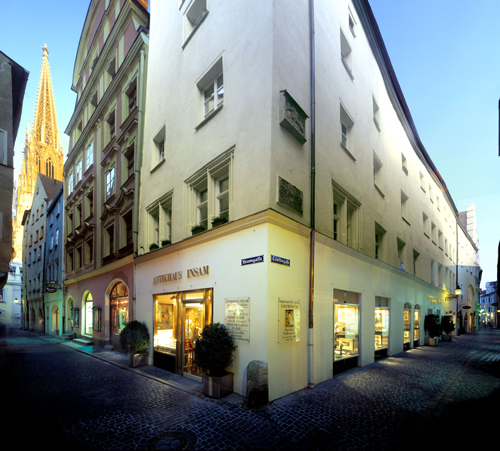Biedermeier
A remarkable example of how furniture design can reflect great historical events is provided by the emergence of the Biedermeier style after Napoleon`s defeat at Waterloo in 1815. The mood of the people of Europe changed - and the style of the furniture altered dramatically to match this mood. As Napoleon had conquered most Europe, the pompous, magnificent Empire style with its grand, monumental mahogany furniture had become extremely fashionable, and palaces and houses were accordingly redecorated throughout the continent.
But after Napoleon`s final defeat, Europe settled down to a long period of peace. The middle classes, who were prospering, wanted a simpler style, which could be functional as well as beautiful. This style, later known as `Biedermeier`, is essentially Empire furniture shorn of its ormolu mounts, excessive gilding and aggressive self-importance. Its original geometric shape often leads it to being described as the forerunner of modern furniture.
Like most styles, it did not have a name while it was being made, but was only given one after it had been and gone. The term ´Biedermeier´ is often wrongly assumed to be the name of a cabinetmaker or designer of the period. During the late 1840s in Austria and Germany, the preceding era (1815-1848) was subject to a barrage of satire, which finally led to the very furniture being mocked. The painterpoet Josef Victor von Scheffel published in 1848 cynical poems with titles as ´Biedermann´s Evening socialising´ and ´Bummelmaier´s Complaint´ in the Viennese satirical magazine ´Fliegende Blätter´(Flying Leaves). These names were combined into the pseudonym `Gottlieb Biedermaier´ by Ludwig Eichrodt, who together with Adolf Kussmaul published poems by the schoolmaster Samuel Friedrich Sauter under this name. The spelling finally changed into ´Biedermeier´ in 1869 when Eichrodt published ´Biedermeier´s Liederlust´.
The term ´Biedermeier´ came to symbolise the middle classes - reliable, with lots of common sense, in fact very boring! ´Bieder´ is a German word meaning common-or-garden, everyday, plain ´Meier´(or Meyer) is a common German surname like Smith.
The misconception that Biedermeier furniture is ´bourgeois´owes everything to the caricaturist and nothing to reality. Many elaborate interiors contained Biedermeier furniture, of course, but the style was adopted at all social levels, from the mercantile to the royal, and its applications varied from the austere to the extravagant.
The most influential furniture designer of the period was Josef Dannhauser (d.1830) who produced many flamboyant pieces. He was the owner of a factory in Vienna (from 1804) with up to 350 workers producing furniture, sculpture and interior decoration. Dannhauser made important pieces of Empire furniture for the Austrian Imperial family. For the middle classes he produced many pieces in the Biedermeier style; there are about 2,500 drawings in the Österreichisches Museum für Angewandte Kunst (the Museum of Applied Arts), as well as numerous printed catalogues with his furniture designs. After his death, his son Joseph took over, but he closed the firm in 1838. Very few pieces survive that are signed, so numerous optimistic attributions to Dannhauser have been made, based on the widespread use of his published catalogues used as pattern books, not only throughout the Austro-Hungarian Empire, but in many other countries as well.
Biedermeier furniture should not be imagined as an individual movement, but rather as a series of ideas stretching from Vienna to Stockholm, encompassing most of the German speaking lands, Scandinavia, Russia and the Austro-Hungarian Empire. In the early nineteen century, there was a tradition of craftsmen travelling around Europe seeking work, which greatly facilitated the spread of these ideas. There are, however, many regional variations to the furniture. South Germany and Austria produced pieces quite unlike those made in Berlin after the designs of Karl Friedrich von Schinkel (1781-1841), the great Prussian architect and designer. North Germany and Denmark were different again.
Biedermeier furniture and interior decoration have enjoyed an upsurge in popularity in Britain and America since World War II. In continental Europe, however, they have exerted a virtually continuous influence upon architects and designers since their rediscovery at the end of the nineteenth century. During this period, the furniture came back into fashion throughout Germany, Austria and Scandinavia and considerable quantities of Biedermeier Revival furniture was made. This continued into the early years of the twentieth century, when it began to influence Josef Hoffmann, the Bauhaus school, Art Deco, Le Corbusier and others In 1979 the Victoria and Albert Museum staged an important exhibition called ´Vienna in the Age of Schubert´, which introduced the British public to the Biedermeier style.
The blond Biedermeier furniture is currently the most sought after. Furniture produced in Austria was usually made in cherry and walnut, as these woods were indigenous to the country. Mahogany was used less often, as it had to be imported. Pieces from Hungary were often made in ash. The South Germans used cherry wood and mahogany most often, but also walnut. In North Germany birch wood and mahogany are most usual,but elm was also popular. In Sweden and Finland birch was the most popular wood, whereas mahogany was mostly used for the grander pieces. The Russians loved their indigenous blond Karelian birch and poplar, but they were often made on the aristocrats estates by their serfs.
Biedermeier today in the US and Britain is an urban style for modern people. New York designers and decorators led the trend before the Europeans rediscoveed the style: New York and Chicago are the main centres for the Biedermeier style today.
Biedermeiers`s subtle appeal lies in its simplicity, which is so easily combined with both Art Deco and contemporary furniture, creating a relaxed mood and informal atmosphere, unlike the many antique styles, which demand a more formal setting.

